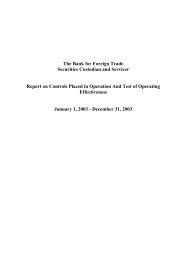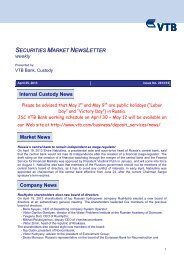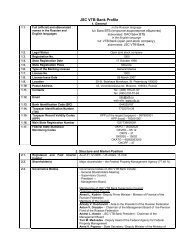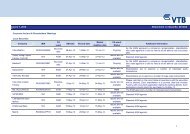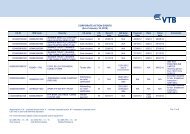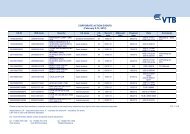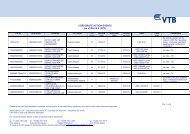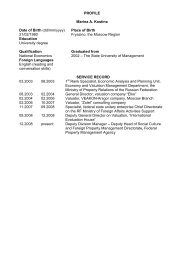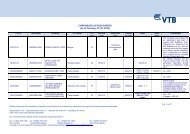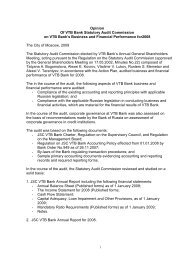Annual report 2011 - VTB
Annual report 2011 - VTB
Annual report 2011 - VTB
- No tags were found...
You also want an ePaper? Increase the reach of your titles
YUMPU automatically turns print PDFs into web optimized ePapers that Google loves.
<strong>VTB</strong> BankNotes to the Consolidated Financial Statements – 31 December <strong>2011</strong> and 2010(in billions of Russian Roubles)38. Financial Risk Management (continued)Liquidity risk and contractual maturity analysisLiquidity risk is a risk resulting from inability of the Group to meet in full its obligations when they fall due and withoutborrowing funds at rates higher than market rates. The Group’s exposure to liquidity risk arises due to a mismatch ofmaturities of assets and liabilities.Liquidity risk management within the Group is carried out at two main levels:Bank/company level: Each bank / company of the Group manages its liquidity on an individual basis to meetits obligations and to comply with the requirements of its national regulator and standards of the Group.Group level: Liquidity of the Group is managed on the basis of centralized control and management of keyactivities of the Group including:- universal policy and approaches to liquidity management, including hedging;- integrated methodology of liquidity risk;- centralized system of on-going <strong>report</strong>ing and data warehousing.The tools used by <strong>VTB</strong> for measurement, management and mitigation of liquidity risk include:Contractual maturity analysis(gap analysis) and cash flow forecasts including:- planned transactions;- forecasted roll-over of clients’ funds (deposits and promissory notes);- possible outflow of unstable “on-demand” funds (clients’ current accounts);Analysis of deposit base concentration;Stress-test analysis;Setting of internal liquidity indicators/limits, including (1) the minimum amount of highly liquid assets to coverpossible outflow of resources on demand/one day and other short-term liabilities (up to 30 days); (2) Treasuryportfolio limits which are monitored on a daily basis;Allocation and utilization of securities from Treasury portfolio, which provide financing from the CBR throughreverse repo operations and help manage short-term liquidity; andDevelopment of emergency plans (funding contingency plans).<strong>VTB</strong> and other banks of the Group are also subject to liquidity requirements set by regulatory authorities, includingthose set by the CBR in the form of prudential ratios.The RD analyses the liquidity position of the Group and prepares liquidity forecasts and recommendations for ALCOon a monthly basis. <strong>VTB</strong>’s Treasury manages short-term liquidity on an ongoing basis through its cash position andportfolio of highly liquid securities and prepares information on short-term liquidity of the Bank and <strong>report</strong>s to theALCO on a weekly basis.The Inflow column in the tables below includes gross amounts to be received by the Group within a certain time bandupon maturities/redemptions of financial instruments (assets/claims). Outflow column includes gross amounts to berepaid by the Group in a certain time band upon maturities/redemptions of financial instruments (liabilities/obligationsexcept current and settlement accounts). Gap represents the difference between Inflow and Outflow columns. GapCumulative column represents the cumulative gap. FX Swap Cumulative column represents the cumulative gaps onforeign exchange swaps. Dynamic Gap (total) Cumulative column represents the cumulative gap including FX SwapCumulative. Opening balance represents highly liquid assets, which mostly consist of cash and Nostro accounts withother banks.82



